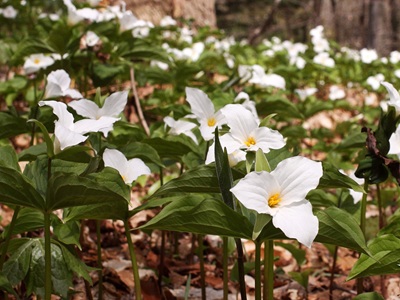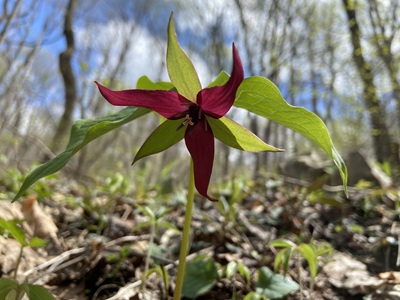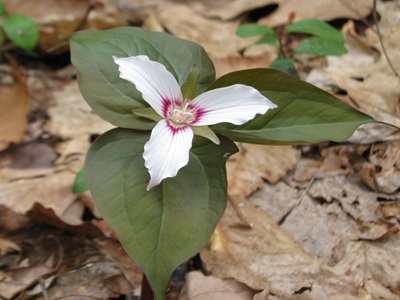Although not the very first flower to bloom in spring, the uniquely beautiful trillium is a harbinger of the season. In fact, some trilliums are called wakerobin — because the flowers appear in early spring before robins begin to appear.
 In Western Pennsylvania, trillium flowers put on an impressive display during April and into May, growing in patches in shaded or dappled woodlands in rich, moist soil. “The best display of trilliums on a Western Pennsylvania Conservancy preserve is probably at Wolf Creek Narrows Natural Area in Butler County,” says Steve Grund, a botanist who has been with the Natural Heritage Program at WPC since 1996. “Our two most common trillium species, large-flowered trillium (Trillium grandiflorum) and wakerobin (Trillium erectum) grow there.” (Another WPC preserve where trillium thrills is Toms Run Nature Reserve in Allegheny County.)
In Western Pennsylvania, trillium flowers put on an impressive display during April and into May, growing in patches in shaded or dappled woodlands in rich, moist soil. “The best display of trilliums on a Western Pennsylvania Conservancy preserve is probably at Wolf Creek Narrows Natural Area in Butler County,” says Steve Grund, a botanist who has been with the Natural Heritage Program at WPC since 1996. “Our two most common trillium species, large-flowered trillium (Trillium grandiflorum) and wakerobin (Trillium erectum) grow there.” (Another WPC preserve where trillium thrills is Toms Run Nature Reserve in Allegheny County.)
“Those species both have multiple common names, and are often called white trillium and red trillium respectively, but both names can be misleading, as there are other species of trillium with white flowers (Trillium grandiflorum flowers also turn pink with age).” Wakerobin, though usually flowering red, also comes in variations of white and yellow.
respectively, but both names can be misleading, as there are other species of trillium with white flowers (Trillium grandiflorum flowers also turn pink with age).” Wakerobin, though usually flowering red, also comes in variations of white and yellow.
“Stinking Benjamin is a cool, if not flattering, name for Trillium erectum,” Steve continues. “Plants with red flowers that have what people perceive as offensive odors are typically pollenated by flies, and I have heard this is the case here.”
Take a close look at trillium flowers and you’ll understand the nomenclature: “Tri” in the Latin word trillium means three. The plant has three leaves, three petals and three stigmas (pollen receptors).
Beloved by spring wildflower enthusiasts, trilliums, like other flowers and native plants, face threats….especially invasive plants and deer. “Deer love to eat trillium flowers,” Steve says. “At Wolf Creek Narrows, the plants have some natural protection from deer because the slopes are pretty steep, and deer don’t like steep slopes.”
Invasive garlic mustard (Alliaria petiolate) is slowly being brought under control at Wolf Creek Narrows with the help of volunteers, who have helped staff pull the plant for about 18 years. “It does take persistent effort to have an effect because the seeds remain viable in the soil for many years–we call this seed banking,” says Steve. “The efforts are showing noticeable results, but we have to remain vigilant.”
Another threat: Humans who cannot resist the urge to pick a beautiful bloom to call their own. Although a perennial plant, as a spring ephemeral trillium is very fragile. Trilliums bloom before the trees grow leaves, so they can get more sunlight and collect nutrients to survive until the following year. If the bloom is picked, the plant cannot collect sunlight and nutrients. It can take years to recover…or not recover at all.
Although a perennial plant, as a spring ephemeral trillium is very fragile. Trilliums bloom before the trees grow leaves, so they can get more sunlight and collect nutrients to survive until the following year. If the bloom is picked, the plant cannot collect sunlight and nutrients. It can take years to recover…or not recover at all.
The slow-growing trilliums take up to 10 years to produce their first flower and live another 10 or 15 years. (Cool fact: Their propagation depends not upon bees, birds or wind…but ants!)
As wonderful as trilliums are, Steve says, don’t forget about other spring wildflowers. “People often ask what is the best time to see spring wildflowers. The answer is the entire spring!” he says. “If you visit the same rich site every week during spring, you will find some different species flowering each time you go.”
